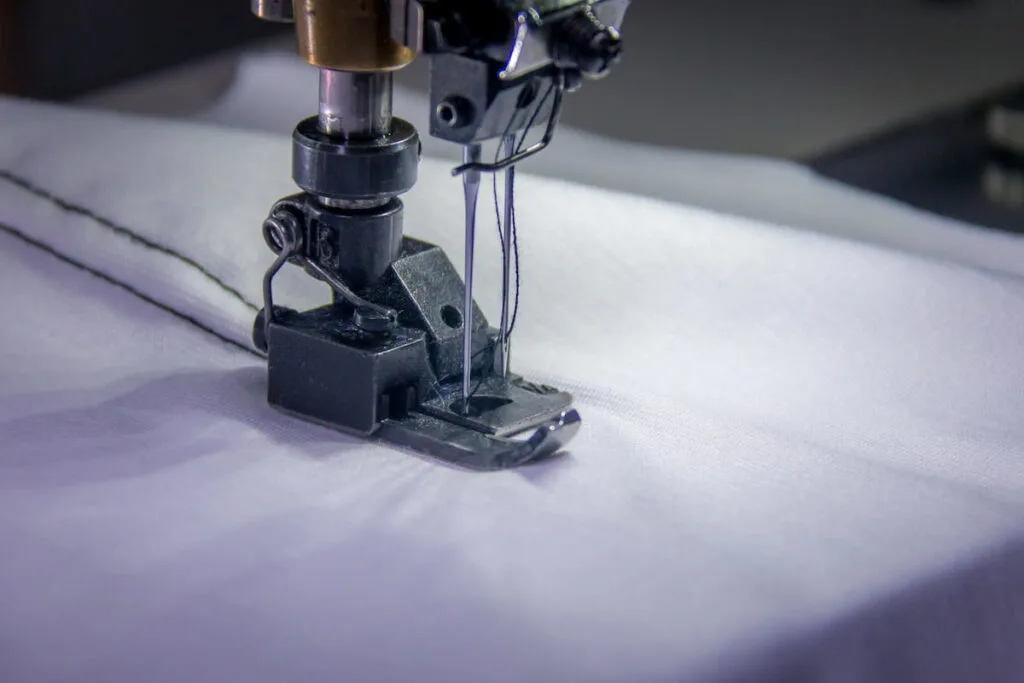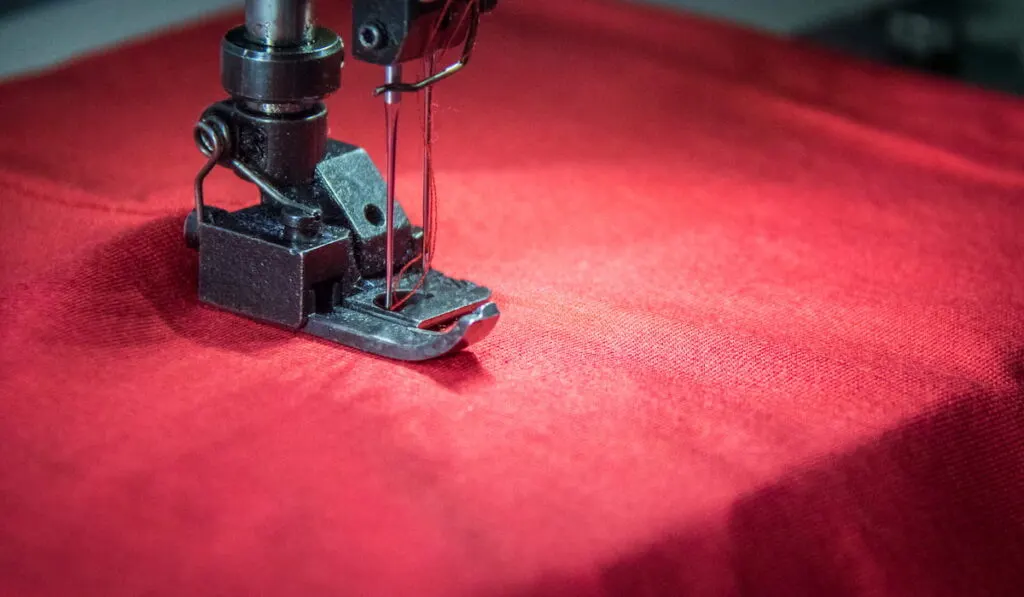Twin, or double needles, are used when a parallel seam is called for in a design. They are also responsible for decorative stitching and stitching that uses two colors to create unique, classic looks. The stitches possible with twin needles range from the simple parallel straight stitches found on t-shirt hems to open, flowing, curled stitching in various colors for decorative purposes.
Typically, seams are tied off at the end of the fabric by using a backstitch (or reverse stitch) to seal the stitching. But this may not work properly with all types of sewing.
Can you backstitch with a twin needle?
It is not recommended to backstitch when starting or finishing your sewing with a twin needle. Instead, the stitching can be lock stitched and tied off, or manually tied off if long thread tails are left, pulled through to the underside, and tied off.

About Twin Needles
Twin needles are two sewing needles fastened together at the tops with specific measurements (in millimeters) between them. They come in several types: denim, universal, stretch, and ballpoint. Each type is used according to user preference and the materials being sown. For example, stretch needles are commonly used on knit fabrics and stretch knits.
The best thing about using a twin needle is that it produces a very professional look.
When using a twin needle, check the manual on your sewing machine in order to identify the needle width that is required. Sometimes, the width is not mentioned, so you can measure the machine to ensure that the needle width fits between the needle plate and the gap in the foot of the machine.
When Can You Use a Twin Needle?
When parallel and decorative stitches are desired, twin needles will give the best results.
The parallel stitches on purchased garments are usually created using a cover stitch machine. However, they can be easily created using a twin needle.
The twin needle that is recommended here is the one with a width of 4.0mm or wider. Twin needles are often used on jerseys and the hems of knit garments in order to create a professional finish.
Twin needles are advantageous as they greatly help in preventing stitches from breaking. The zigzag stitches that are created on the underside of the garment provide strength to the seams.
A twin needle can also be used when one wants to create pintucks, a simulation of cover stitch hems, free motion quilting, and topstitching of parallel rows.
Pintucks are created by stitching them on a single layer of fabric with a pintuck foot and are found on garments that are lightweight, sheer, and knits. With a twin needle, it is easy to add additional rows of pintucks in alignment with one another.

How to Put in a Twin Needle
Begin installing a twin needle by setting up for sewing. Adjust the measurement of your sewing machine to maximum readings and set it to a zigzag stitch.
Next, run a piece of scrap through the machine. Then measure the width of the zigzag. This will help you to identify the type of twin needle you can use according to the measured width.
After identifying the type of twin needle you will use, remove your regular single needle, and replace it with the twin needle.
Ensure that the flat part of the top shank is placed towards the back. Then insert the top post into the needle hole.
Make sure that you tighten the screw and that the shank is facing the right direction. Replace the presser foot by inserting your zigzag foot on the machine and ensure that the needle fits in the slot.
On the spool pin, (most sewing machines have this), place the other thread and when threading, ensure that you treat the two threads as one.
If your machine does not have the spool pin, you can use the bobbin winder spindle to hold the bobbin. Or use a dowel that is the same diameter as the spool pin, placing it on one side of your machine using tape.
On each separate guide, put a thread and then you can insert one thread in each eye of the needle. Then attach the zigzag foot. You can ensure that your machine is set on and has a straight stitch by sewing through plain paper or scrap material.
Which Presser Feet Work with Twin Needles
A presser foot refers to a device on a sewing machine for holding the garment flat as it passes through the machine. It can be a lifesaver to the person sewing.
Your sewing machine manual often has an indication of which presser foot can be used in different situations. The most commonly used presser foot is the zigzag foot.
Can You Use a Twin Needle on any Sewing Machine?
A twin needle can be used on any sewing machine as long as the machine can sew both a zigzag stich and a straight stitch. Sewing machines that can only sew the straight stitch and not the zigzag stitch cannot use the twin needle.
Sewing Projects You Might Use a Twin Needle For
Making Hems
Twin needles can be used when making hems that are similar to cover stitch hems. Usually, a size 4mm needle is used to obtain the best and most professional results.
Sewing Seams on Sheer Fabrics

The twin needle can come in handy in the project of sewing the seams of sheer fabrics. In order to avoid the bulkiness of the material at the seams, the allowances of the seams are closely cut off, although this does not provide the most durable seams.
Ribbon Trims
Using the correct size of the twin needle, a ribbon trim can be easily affixed to another fabric with parallel stitching sized to the ribbon.
Making Parallel Rows of Top Stitching
When one has a project of sewing parallel stitches, twin needles yield the best parallel lines at one time.
Decorative Stitches
The best decorative stitches can be obtained when the width is correctly selected and different colors are used. Many decorative stitches can be obtained this way in less time.
Making Pintucks
As described earlier, beautiful pintucks can be sewn by using twin needles and the pintuck foot. Using the twin needle will give allowance for additional rows in less time.
Resources
- https://www.thingsforboys.com/2013/12/sewing-101-hemming-with-double-twin.html
- https://youtu.be/Uul2orWuLOA
- https://www.sewessential.co.uk/blog/sewing-twin-needle/
- https://www.heirloomcreations.net/can-i-use-a-double-needle/
- https://blog.treasurie.com/twin-needle-double-needle/
- https://sewguide.com/double-twin-needle-sewing/
